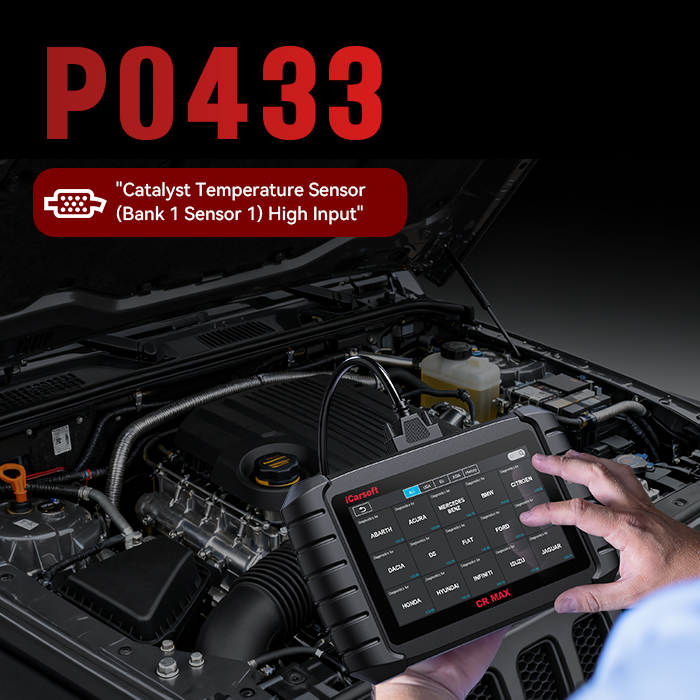Last updated: 2025-10-15
Author: Mike – Porsche DIY Enthusiast since 2012
🔍 What Does Code P0433 Mean?
The P0433 code indicates that the Engine Control Module (ECM) has determined the warm-up catalytic converter on Bank 2 (Sensor 2) is not performing efficiently enough. This means the post-catalyst oxygen sensor (O2 Sensor 2) on Bank 2 detects gas composition similar to the pre-catalyst sensor, suggesting the catalyst isn’t reducing emissions effectively.
In simple terms, the catalytic converter is either slow to reach operating temperature or its oxygen storage capacity has degraded.
For an official definition, refer to the OBD-Codes.com entry for P0433 which classifies it under “Warm Up Catalyst Efficiency Below Threshold (Bank 2)”.
Commonly Affected Models: Porsche Cayenne, Macan, 911, Audi Q7, Volkswagen Touareg, and other vehicles using shared V6/V8 engines.
⚙️ What Causes Code P0433?
- Degraded or contaminated catalytic converter on Bank 2
- Faulty downstream oxygen sensor (Sensor 2)
- Exhaust leaks near the manifold or catalytic converter
- Rich or lean fuel mixture due to injector or air leak issues
- Engine misfires sending unburnt fuel into the catalyst
- ECM software not updated (check with OEM TSBs)
- Low-quality or leaded fuel damaging the catalyst
According to the U.S. EPA Vehicle Emission Certification Guide, sustained catalyst inefficiency can significantly increase HC and NOx emissions—making early diagnosis essential.
🚨 Common Symptoms of P0433
- Check Engine Light (CEL) on
- Reduced fuel efficiency
- Noticeable power loss or sluggish acceleration
- Rattling noise from catalytic converter
- Sulfur or “rotten egg” smell from exhaust
- Failed emissions test or readiness monitor
🧰 How to Diagnose and Fix Code P0433
Step 1 – Confirm the Code
Use iCarsoft CR MAX to confirm P0433 and check for related O2 sensor or misfire codes. Record freeze-frame data to know if it appeared during cold start or highway cruising.
Step 2 – Inspect Exhaust and Wiring
Visually inspect for cracks, loose connections, or leaks in the Bank 2 exhaust system. Ensure the downstream O2 sensor wiring is intact and not contaminated by oil or moisture.
Step 3 – Compare O2 Sensor Readings
Use live data mode to review voltage signals from both O2 sensors on Bank 2. The upstream (Sensor 1) should fluctuate rapidly (0.1–0.9V), while the downstream (Sensor 2) should remain stable around 0.6–0.8V. If both fluctuate similarly, the catalyst has lost efficiency.
Learn more about interpreting O2 data from RepairPal’s OBD-II code guide.
Step 4 – Measure Catalyst Temperature
Using an infrared thermometer, measure the catalytic converter’s inlet and outlet temperature after 5 minutes of engine operation. A healthy converter should show a rise of 100–200°F at the outlet. If temperatures are equal, the catalyst may be thermally inactive.
Step 5 – Replace Faulty Components
If O2 sensors and wiring are fine, replace the Bank 2 catalytic converter. Use only OEM or CARB-approved parts to avoid check engine recurrence. After replacement, clear codes using the iCarsoft CR MAX and perform a complete drive cycle.
🧠 Technical Insight: Why P0433 Happens
The ECM constantly compares the switching frequency and amplitude of upstream and downstream O2 sensors to assess catalyst oxygen storage. If the downstream sensor mirrors the upstream too closely, or the catalyst takes too long to heat up, it fails the “Warm-Up Efficiency Test.”
More detailed engineering background can be found in the SAE Technical Paper 2003-01-0853, which discusses catalyst monitoring algorithms used in OBD-II systems.
❓ FAQ – Common Questions About P0433
Q1: Can I still drive with code P0433?
Yes, but extended driving may overheat the catalytic converter and increase emissions. EPA regulations require emission system efficiency within strict thresholds.
Q2: How to confirm if the catalyst or O2 sensor is bad?
Check live sensor data. If both sensors switch similarly, the catalyst is at fault. If one O2 sensor signal is stuck or erratic, replace the sensor first.
Q3: Can bad fuel cause P0433?
Absolutely. Fuel with metallic additives or lead residue can poison the catalyst surface and reduce its oxygen absorption rate.
Q4: Do Porsche vehicles have TSBs for P0433?
Yes, several TSBs reference premature catalyst degradation on Cayenne and Macan models. You can find these on the official NHTSA Recall & TSB Database.













